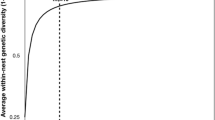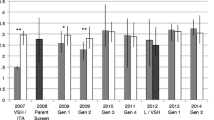Abstract
The pollen hoarding syndrome consists of a large suite of correlated traits in honey bees that may have played an important role in colony organization and consequently the social evolution of honey bees. The syndrome was first discovered in two strains that have been artificially selected for high and low pollen hoarding. These selected strains are used here to further investigate the phenotypic and genetic links between two central aspects of the pollen hoarding syndrome: sucrose responsiveness and pollen hoarding. Sons of hybrid queen offspring of these two strains were tested for sucrose responsiveness and used to produce colonies with either a highly responsive or an unresponsive father. These two colony groups differed significantly in the amount of pollen stored on brood combs and with regard to their relationship between brood and pollen amounts. Additionally, four quantitative trait loci (QTL) for pollen hoarding behavior were assessed for their effect on sucrose responsiveness. Drone offspring of two hybrid queens were phenotyped for responsiveness and genotyped at marker loci for these QTL, identifying some pleiotropic effects of the QTL with significant QTL interactions. Both experiments thus provided corroborating evidence that the distinct traits of the pollen hoarding syndrome are mechanistically and genetically linked and that these links are complex and dependent on background genotype. The study demonstrates genetic worker–drone correlations within the context of the pollen hoarding syndrome and establishes that an indirect selection response connects pollen hoarding and sucrose responsiveness, regardless of which trait is directly selected.



Similar content being viewed by others
References
Amdam GV, Csondes A, Fondrk MK, Page RE (2006) Complex social behaviour derived from maternal reproductive traits. Nature 439:76–78
Amdam GV, Norberg K, Fondrk MK, Page RE Jr (2004) Reproductive ground plan may mediate colony-level selection effects on individual foraging behavior in honey bees. Proc Natl Acad Sci U S A 101:11350–11355
Beshers SN, Fewell JH (2001) Models of division of labor in social insects. Annu Rev Entomol 46:413–440
Dreller C, Tarpy DR (2000) Perception of the pollen need by foragers in a honeybee colony. Anim Behav 59:91–96
Fewell JH, Winston ML (1992) Colony state and regulation of pollen foraging in the honey-bee, Apis mellifera L. Behav Ecol Sociobiol 30:387–393
Gadagkar R (1997) The evolution of caste polymorphism in social insects: genetic release followed by diversifying evolution. J Genet 76:167–179
Gadau J, Fewell J (2009) Organization of insect societies—from genome to sociocomplexity. Harvard University Press, Cambridge
Graham AM, Munday MD, Kaftanoglu O, Page RE Jr, Amdam GV, Rueppell O (2011) Support for the reproductive ground plan hypothesis of social evolution and major QTL for ovary traits of Africanized worker honey bees (Apis mellifera L.). BMC Evol Biol 11:95
Hunt GJ, Amdam GV, Schlipalius D, Emore C, Sardesai N, Williams CE, Rueppell O, Guzman-Novoa E, Arechavaleta-Velasco M, Chandra S, Fondrk MK, Beye M, Page RE (2007) Behavioral genomics of honeybee foraging and nest defense. Naturwissenschaften 94:247–267
Hunt GJ, Page RE Jr, Fondrk MK, Dullum CJ (1995) Major quantitative trait loci affecting honey bee foraging behavior. Genetics 141:1537–1545
Kuwabara M (1957) Bildung des bedingten Reflexes vom Pavlov Typus bei der Honigbiene (Apis mellifica). J Fac Sci Hokkaido Univ Zool 13:458–464
Laidlaw HH, Page RE (1997) Queen rearing and bee breeding. Wicwas, Cheshire
Linksvayer TA, Kaftanoglu O, Akyol E, Blatch S, Amdam GV, Page RE (2011) Larval and nurse worker control of developmental plasticity and the evolution of honey bee queen-worker dimorphism. J Evol Biol 24:1939–1948
Linksvayer TA, Rueppell O, Siegel A, Kaftanoglu O, Page RE, Amdam GV (2009) The genetic basis of transgressive ovary size in honey bee workers. Genetics 183:693–707
Page RE, Erber J (2002) Levels of behavioral organization and the evolution of division of labor. Naturwissenschaften 89:91–106
Page RE, Fondrk MK (1995) The effects of colony level selection on the social organization of honey bee (Apis mellifera L) colonies—colony level components of pollen hoarding. Behav Ecol Sociobiol 36:135–144
Page RE, Fondrk MK, Hunt GJ, Guzman-Novoa E, Humphries MA, Nguyen K, Greene AS (2000) Genetic dissection of honeybee (Apis mellifera L.) foraging behavior. J Hered 91:474–479
Page RE, Rueppell O, Amdam GV (2012) A review of the connections between reproductive and social behavioral traits with special emphasis on the honey bee. Annu Rev of Genet 46:97–119
Page RE, Scheiner R, Erber J, Amdam GV (2007) The development and evolution of division of labor and foraging specialization in a social insect (Apis mellifera L.). Curr Top Dev Biol 74:253–286
Pankiw T (2003) Directional change in a suite of foraging behaviors in tropical and temperate evolved honey bees (Apis mellifera L.). Behav Ecol Sociobiol 54:458–464
Pankiw T, Page RE (1999) The effect of genotype, age, sex, and caste on response thresholds to sucrose and foraging behavior of honey bees (Apis mellifera L.). J Comp Physiol A 185:207–213
Pankiw T, Page RE (2000) Response thresholds to sucrose predict foraging division of labor in honeybees. Behav Ecol Sociobiol 47:265–267
Pankiw T, Page RE (2001) Genotype and colony environment affect honeybee (Apis mellifera L.) development and foraging behavior. Behav Ecol Sociobiol 51:87–94
Pankiw T, Page RE, Fondrk MK (1998) Brood pheromone stimulates pollen foraging in honey bees (Apis mellifera). Behav Ecol Sociobiol 44:193–198
Rueppell O (2009) Characterization of quantitative trait loci for the age of first foraging in honey bee workers. Behav Genet 39:541–553
Rueppell O, Bachelier C, Fondrk MK, Page RE Jr (2007) Regulation of life history determines lifespan of worker honey bees (Apis mellifera L.). Exp Gerontol 42:1020–1032
Rueppell O, Chandra SBC, Pankiw T, Fondrk MK, Beye M, Hunt GJ, Page RE (2006a) The genetic architecture of sucrose responsiveness in the honey bee (Apis mellifera L.). Genetics 172:243–251
Rueppell O, Fondrk MK, Page RE (2006b) Male maturation response to selection of the pollen-hoarding syndrome in honey bees (Apis mellifera L.). Anim Behav 71:227–234
Rueppell O, Kaftanouglu O, Page RE (2009) Honey bee (Apis mellifera) workers live longer in small than in large colonies. Exp Gerontol 44:447–452
Rueppell O, Metheny JD, Linksvayer TA, Fondrk MK, Page RE Jr, Amdam GV (2011) Genetic architecture of ovary size and asymmetry in European honeybee workers. Heredity 106:894–903
Rueppell O, Pankiw T, Nielson DI, Fondrk MK, Beye M, Page RE Jr (2004) The genetic architecture of the behavioral ontogeny of foraging in honey bee workers. Genetics 167:1767–1779
Rüppell O, Pankiw T, Page RE Jr (2004) Pleiotropy, epistasis and new QTL: the genetic architecture of honey bee foraging behavior. J Hered 95:481–491
Scheiner R, Barnert M, Erber J (2003) Variation in water and sucrose responsiveness during the foraging season affects proboscis extension learning in honey bees. Apidologie 34:67–72
Scheiner R, Page RE, Erber J (2001) Responsiveness to sucrose affects tactile and olfactory learning in preforaging honey bees of two genetic strains. Behav Brain Res 120:67–73
Scheiner R, Page RE, Erber J (2004) Sucrose responsiveness and behavioral plasticity in honey bees (Apis mellifera). Apidologie 35:133–142
Schmickl T, Crailsheim K (2007) HoPoMo: a model of honeybee intracolonial population dynamics and resource management. Ecol Model 204:219–245
Wang Y, Amdam GV, Rueppell O, Wallrichs MA, Fondrk MK, Kaftanoglu O, Page RE Jr (2009) PDK1 and HR46 gene homologs tie social behavior to ovary signals. PLoS One 4:e4899
Winston ML (1987) The biology of the honey bee. Harvard University Press, Cambridge
Acknowledgments
Tanya Pankiw conducted the PER analyses for the drones used in this study. Financial support for this project was provided by the National Science Foundation (grants #0090482 and #0076811 to REP and #0615502 and #0926288 to OR), the Agriculture and Food Research Initiative of the USDA National Institute of Food and Agriculture (#2010-65104-20533 to OR), and the National Institute on Aging (NIA P01 AG22500 to REP).
Author information
Authors and Affiliations
Corresponding author
Additional information
Communicated by R. F. A. Moritz
Rights and permissions
About this article
Cite this article
Page, R.E., Fondrk, M.K. & Rueppell, O. Complex pleiotropy characterizes the pollen hoarding syndrome in honey bees (Apis mellifera L.). Behav Ecol Sociobiol 66, 1459–1466 (2012). https://doi.org/10.1007/s00265-012-1400-x
Received:
Revised:
Accepted:
Published:
Issue Date:
DOI: https://doi.org/10.1007/s00265-012-1400-x




